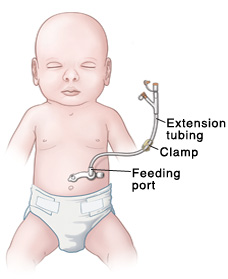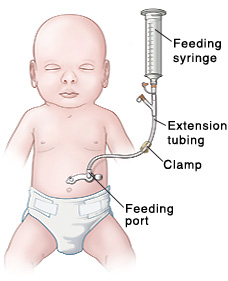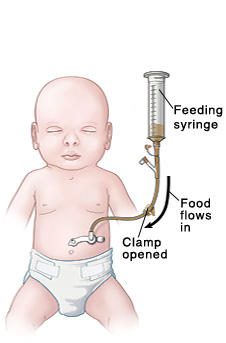Gastrostomy or Gastro-jejunum Tube: Syringe Feeding
Gastrostomy or Gastro-jejunum Tube: Syringe Feeding
Your child is going home with either a gastrostomy tube (G tube) or gastro-jejunum tube (G-J tube) in place. A G-tube is placed through the abdominal wall into the stomach. This tube sends liquid food directly into the stomach. A G-J tube is placed through the abdominal wall into the stomach and leads into part of the small intestine called the jejunum. It sends liquid food directly into the jejunum. You’ll need to feed your child through this tube. You were shown how to do this before your child was discharged from the hospital. This sheet will help you remember those steps at home. If you need more help, talk with the hospital about how to arrange a home health nurse to help you.
Keep in mind that there are many types of G and G-J tubes, syringes, and feeding pumps. Your child’s tube and supplies may look or work differently from what are described and shown here. Make sure to follow the instructions given by your child’s healthcare provider or home health nurse.
Contact information to keep handy
Ask for phone numbers to call if you need help. Also, make sure you have the phone number for your child’s medical supply company. You’ll need to order more supplies for your child in the future. Write all of these phone numbers below.
Healthcare provider phone number: _____________________________________
Home health nurse phone number: ______________________________________
Medical supply company phone number: __________________________________
Types of feeding
There are 2 types of feeding with G and G-J tubes. Your child may be have one or both types of feeding. They are:
Continuous feeding. Liquid food is dripped slowly through the tube for part or all of a day. Continuous feeding can be done into either the stomach or the jejunum. This type of feeding is only done using a pump. The amount of food to be given and time frame are often set on the pump for you. Do not change pump settings unless you’re instructed to do so.
Bolus feeding. This is a meal-sized amount of liquid food given through the tube several times a day. Bolus feeding is given using a syringe or a pump. Bolus feeding is done into the stomach but not into the jejunum. Your child’s healthcare provider or home health nurse will tell you how much liquid food to use for each feeding. You’ll also be told how often to feed your child.
For bolus feeding, fill in the numbers below:
Feed your child on this schedule: _____________________________________________
Give this much at each feeding: ______________________________________________
Feeding your child
The supplies you’ll need are:
Liquid food
Feeding syringe
Extension tubing
|
|
|
|
Follow these steps:
Wash your hands with soap and water.
Check the label and expiration date of the liquid food. Don’t use any can or bag of food if the expiration date has passed. Instead, get a new can or bag of food.
Open the feeding port cap on the G or G-J tube.
Connect the extension tubing to the feeding port of the G or G-J tube.
Make sure the clamp on the extension tubing is closed.
Pull the plunger out of the feeding syringe.
Connect the feeding syringe to the other end of the extension tubing.
Pour the liquid food into the feeding syringe. Fill only to the amount that was prescribed by your child’s healthcare provider.
Open the clamp on the extension tubing.
Hold the feeding syringe straight up. This allows the food to run through the G or G-J tube by gravity. Adjust the angle of the feeding syringe to control the flow rate of the food.
If the food flows too slowly or doesn’t flow at all, place the plunger in the syringe. Gently push the plunger a bit. This can help remove anything that is blocking or clogging the tube. Do not push the plunger all the way into the syringe or with force.
Refill the feeding syringe with food, if needed. Repeat steps until your child has received the prescribed amount of food.
After the feeding, flush the extension tubing with water, as you were shown in the hospital.
Disconnect the syringe from the extension tubing.
Disconnect the extension tubing from the G or G-J tube.
Close the feeding port cap on the G or G-J tube.
|
|
|
Additional instructions: ______________________________________________________
_________________________________________________________________________
_________________________________________________________________________
_________________________________________________________________________
When to call the healthcare provider
Contact the healthcare provider right away if any of the following occurs:
Your child has trouble breathing.
The tube feels loose or comes out.
The opening where the tube enters the skin becomes larger.
Red, rough tissue forms around the tube site.
The tube becomes clogged or blocked and you can’t clear it.
The skin around the tube site has redness, swelling, leaking fluid, or sores.
You see blood around the tube, in your child’s stool, or in the contents of the stomach.
Your child coughs, chokes, or vomits while feeding.
Your child’s belly looks bloated or feels hard when gently pressed.
Your child has diarrhea or constipation.
Your child has a fever 100.4°F (38°C) or higher.
Updated:
October 08, 2017
Sources:
Bankhead, R. Enteral Nutrition Practice Recommendations. Journal of Parenteral and Enteral Nutrition (2009); 33(2); pp. s122-s167
Reviewed By:
Adler, Liora C., MD,Freeborn, Donna, PhD, CNM, FNP




